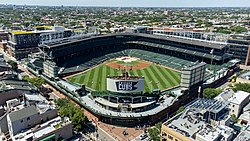
Back Wrigley Field Catalan Wrigley Field CEB Wrigley Field Danish Wrigley Field German Wrigley Field Spanish Wrigley Field Basque Wrigley Field Finnish Wrigley Field French Wrigley Field Frisian Wrigley Field Galician
"The Friendly Confines" Cubs Park | |
 | |
 Wrigley Field in 2022 | |
 | |
| Former names | Weeghman Park (1914–1920) Cubs Park (1920–1926) |
|---|---|
| Address | 1060 West Addison Street |
| Location | Chicago, Illinois (60613-4397) |
| Coordinates | 41°56′53″N 87°39′20″W / 41.94806°N 87.65556°W |
| Public transit | Red at Addison |
| Owner | Ricketts family |
| Operator | Chicago Cubs |
| Capacity | 41,649[7] |
| Record attendance | 47,171[1] (August 31, 1948 vs. Brooklyn Dodgers) |
| Field size | Left field – 355 ft (108.2 m) Left-center – 368 ft (112.2 m) Center field – 400 ft (121.9 m) Right-center – 368 ft (112.2 m) Right field – 353 ft (107.6 m) Backstop – 55 ft (16.8 m) Outfield wall height: Bleachers – 11 ft 6 in (3.5 m) Corners – 15 ft (4.6 m)[2]  |
| Surface | Merion bluegrass |
| Construction | |
| Broke ground | March 4, 1911 |
| Opened | April 23, 1914 |
| Renovated | 1937, 1988, 2014–2019 |
| Expanded | 1922, 1927, 2006 |
| Construction cost | US$250,000 (US$7.6 million in 2023 dollars[6]) |
| Architect | Zachary Taylor Davis |
| General contractor | Blome-Sinek Company |
| Tenants | |
| Chicago Whales (FL) (1914–1915) Chicago Cubs (MLB) (1916–present) Chicago Tigers (APFA) (1920) Hammond Pros (NFL) (1920–1926) Chicago Bears (NFL) (1921–1970) Chicago Cardinals (NFL) (1931–1939) Chicago Sting (NASL) (1977–1982, 1984)[3] | |
| Designated | February 1, 2004 |
| Designated | September 23, 2020[a] |
Wrigley Field /ˈrɪɡli/ is a baseball stadium on the North Side of Chicago, Illinois. It is the ballpark of Major League Baseball's Chicago Cubs, one of the city's two MLB franchises. It first opened in 1914 as Weeghman Park for Charles Weeghman's Chicago Whales of the Federal League, which folded after the 1915 baseball season. The Cubs played their first home game at the park on April 20, 1916, defeating the Cincinnati Reds 7–6 in 11 innings. Chewing gum magnate William Wrigley Jr. of the Wrigley Company acquired the Cubs in 1921. It was named Cubs Park from 1920 to 1926, before being renamed Wrigley Field in 1927. The stadium currently seats 41,649 people[7] and is the second stadium to be named Wrigley Field, as a Los Angeles ballpark with the same name opened in 1925.
In the North Side community area of Lakeview in the Wrigleyville neighborhood, Wrigley Field is on an irregular block bounded by Clark and Addison streets to the west and south, and Waveland and Sheffield avenues to the north and east. Wrigley Field is nicknamed "The Friendly Confines", a phrase popularized by Hall of Fame shortstop and first baseman Ernie Banks. The oldest park in the National League, it is the second-oldest in the majors after Fenway Park (1912), and the only remaining Federal League park.[8] The park was designated a National Historic Landmark in 2020.[9]
Wrigley Field's features include its ivy-covered brick outfield wall, distinctive wind patterns off Lake Michigan, the red marquee over the main entrance, and the hand-turned scoreboard. The stadium is situated in a primarily residential neighborhood without parking lots, and spectators have views from the rooftops behind the outfield. Additionally, it was the last Major League park to have lights installed for night games, in 1988. From 1921 to 1970, the stadium was also home to the Chicago Bears of the National Football League, and from 1931 to 1938, it was the home of the Chicago Cardinals (now the Arizona Cardinals) of the National Football League. The elevation of its playing field is 600 feet (180 m) above sea level.
- ^ "Brooklyn Dodgers at Chicago Cubs Box Score, August 31, 1948". Baseball-Reference.com. Retrieved July 22, 2022.
- ^ "Wrigley Field History". MLB.com. Retrieved July 6, 2023.
- ^ "Hockey Adds Another Moment to Wrigley's History". FOX Sports. Retrieved March 27, 2011.[permanent dead link]
- ^ "Wrigley Field - National Historic Landmarks (U.S. National Park Service)". Archived from the original on May 30, 2020.
- ^ "Weekly list of actions, 11/27/20 to 12/04/20". National Park Service. Retrieved December 4, 2020.
- ^ 1634–1699: McCusker, J. J. (1997). How Much Is That in Real Money? A Historical Price Index for Use as a Deflator of Money Values in the Economy of the United States: Addenda et Corrigenda (PDF). American Antiquarian Society. 1700–1799: McCusker, J. J. (1992). How Much Is That in Real Money? A Historical Price Index for Use as a Deflator of Money Values in the Economy of the United States (PDF). American Antiquarian Society. 1800–present: Federal Reserve Bank of Minneapolis. "Consumer Price Index (estimate) 1800–". Retrieved February 29, 2024.
- ^ a b "Wrigley Field". baseballinstadiums.com. Retrieved July 6, 2023.
- ^ Focus; Wrigley Field: the Unauthorized Biography, Interview with Stuart Shea, March 9, 2005, WILL Illinois Public Media, American Archive of Public Broadcasting (WGBH and the Library of Congress), Boston, MA and Washington, D.C., accessed October 3, 2016.
- ^ "Wrigley Field Designated as a National Historic Landmark" (Press release). United States Department of the Interior. November 19, 2020. Retrieved November 19, 2020.
Cite error: There are <ref group=lower-alpha> tags or {{efn}} templates on this page, but the references will not show without a {{reflist|group=lower-alpha}} template or {{notelist}} template (see the help page).
© MMXXIII Rich X Search. We shall prevail. All rights reserved. Rich X Search